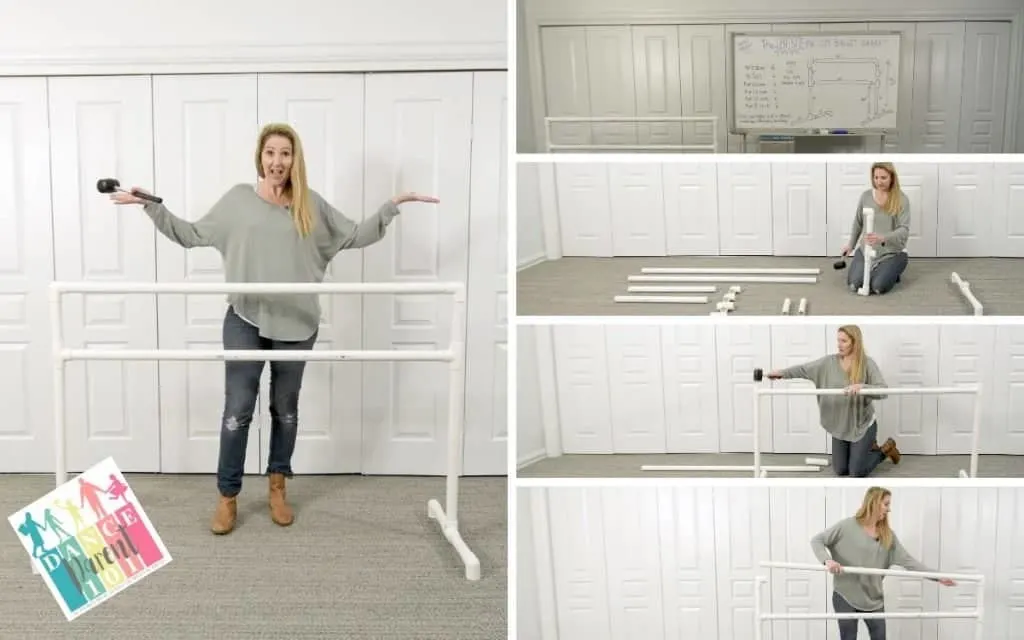
2020 has been a wild ride hasn’t it! I never would have dreamed my girls would have been doing their ballet lessons online and at home but this is what pushed me to find out how to make a DIY home ballet barre.
To make a sturdy DIY Ballet barre you need 20 feet of C-PVC pipe, a hack saw or pipe cutter, pipe fittings – 6 elbows and 4 tees, a measuring tape, and plumbers cement. Step by step instructions on how to cut & piece them all together can be found below!
I had never made a DIY Ballet Barre before, and even though I consider myself a DIY kind of girl, this project was putting me out of my comfort zone. I had never used PVC pipes before and had no idea what I needed to buy and got extremely confused when I got to the store to find there were all different kinds of pvc pipe. Next up, was what type of barre did I want to make and why did every tutorial I watch on YouTube give me a different set of measurements to work with? And why didn’t they didn’t always tell me what width of pipe they were using or if it was pressure or drainage pipe and so I got confused about which one should I use and follow?

So I decided that I would make them all! Ok well not all of them, but I kept coming across three measurements in particular for a PVC ballet barre, but I wasn’t quite sure which would be best, so I made those three which you can view on YouTube here. So I have taken all the hard work and guesswork out of the equation for you now because, from that experiment, I decided on the measurements for the BEST DIY ballet barre that I am going to share with you today!
STEP BY STEP INSTRUCTIONS – HOW TO MAKE A DIY DOUBLE BALLET BARRE
For a pdf printout with a list of the tools, materials and cuts you need to make as well as a small diagram and simple instructions click here to join our newsletter so you can access the newsletter member area with free printables and more!
- Step 1: Gather your tools and materials.
- Step 2: Cut your PVC pipe
- Step 3: Assemble the fittings and PVC pipe
- Step 4: Secure the fittings together with a rubber mallet, glue or screws
- Step 5: Paint your PVC Ballet Barre
- Step 6: Your DIY Ballet Barre is ready to use!
- Check Out Our Google Web Story!
- LEAVE A COMMENT
Step 1: Gather your tools and materials.
WHAT YOU WILL NEED
TOOLS or EQUIPMENT:
- Hack Saw
- Rubber Mallet
- Measuring Tape
- Steel Wool
- Permanent Marker
- 2 Chairs or 2 Work Horse or even bricks to lie pipe across to cut
OPTIONAL EQUIPMENT - Acetone for cleaning marks and printed barcodes
- Glue for PVC pipes or Screws if using
- Paint for plastic surfaces
MATERIALS
- PVC Pressure Pipe 1.25″ diameter (32mm)
1 x 20 foot long (6 meters)
OR
2 x 10 foot long (3 meter) PVC Pressure Pipe - 6 x elbows for pressure pipe 1.25″
- 4 x tees for pressure pipe 1.25″
What type of PVC pipe should I use?
When you go to your plumbing supply or hardware story you will find that there will be two different types of pipe available to you. For this barre I have used pressure pipe which has fittings that have 90 degree angles. The other type of pvc pipe you might come across is drainage pipe and the fittings for that pipe have 88 degree angles to enable water to easily drain through them. For more information about these different types of pipe and why 1.25″ pressure pipe is virtually the same width as 1.5″ drainage pipe and for a tutorial where I make a barre with drainage pipe click here.
What diameter pipe is best?
For this particular ballet barre I have used 1.25″ or 32mm diameter PVC pressure pipe as I found the width of this pipe felt best under my hand and wasn’t too wide for my kids either. If you are unable to get 1.25″ I have seen other tutorials where 1.5″ or 40mm PVC pipe was used so it will be ok just a little chunkier. If you are using drainage pipe (refer to the previous point about which type of pipe you should use) 1.5″ has the around the same size outer diameter as 1.25″ pressure pipe anyway.
Step 2: Cut your PVC pipe
For this DIY ballet barre you will need to cut your PVC pipe into the following lengths:
- 2 x 60″
- 4 x 10″
- 2 x 26″
- 2 x 8″
Whether you buy your pipe in one long 20 foot (6 meter) length or two 10 foot (3 meter) lengths it shouldn’t matter in what order you cut your pipe.
‘If your hardware or plumbing supply store can only cut your pieces into half lengths to fit into your car – that is fine – this means you will end up with four 60″ pieces and you need 2 pieces this length for your barre anyway and that just means one less cut for you to do at home!’
I ended up buying my PVC pipe in 20-foot lengths and had it delivered as I experimented and made a whole heap of barres so I could create tutorials on how to make them. But when I began this journey of barre making I went to a big hardware warehouse where they sold the pipes in 10 foot or 3-meter lengths only. When I went to enquire in the lumbar yard area where they custom cut wood if they could do the same for my pipes, they told me they don’t because it messes up their blade and so they will only cut the pipe in half for me so I can get it into my car. For this barre that is absolutely fine, because half of 10 feet is 60 inches and you need two of those anyway! And the total length of the rest of the cuts is less than 60 inches so it works out fine!
HOW TO CUT PVC?
If your hardware or plumbing supply store can’t make the cuts for you and you have access to a miter saw and know how to use one – then go ahead and use that. If you have no idea what a miter saw is or how to use one, don’t worry, I didn’t use one.
I used a simple hacksaw and if you go to the YouTube video on how to make this barre and skip or scrub to timecode 7:57 you can see the exact method I used or if you prefer you can watch the video below on which gives more details on what I did and gives you some other options. If you can use a knife in the kitchen safely to cut food, then you should easily be able to use a hack saw to slice through the PVC pipe!
I simply used the measuring tape to measure a length I needed, marked this with the permanent marker and laid the pipe onto a couple of chairs for support, and then pushed the hacksaw back and forth where I had marked the pipe. I found that the saw would get stuck if I tried to hold the pipe together if I let the piece I was cutting off hang loosely, gravity created enough gap where I was cutting for the saw to slide back and forth. I would sometimes also rotate the pipe around to get to the last few centimeters that needed to be cut.
Once cut, I would use steel wool to clean off all the shredded pieces of PVC that clung to the edges of the pipe. At first I used sand paper, but found steel wool to work much more efficiently and quickly.

Once you have all your materials assembled and your PVC is cut into the right lengths you can follow the instructions:
Step 3: Assemble the fittings and PVC pipe

The image above should hopefully give you a good visual on how to put all the pieces together and the video gives you a step by step walk through of how to do it as well…..but if you would like to read the instructions, on how to build this 41″ tall ballet barre that I think is great for both kids and adults to use keep on reading here.
Start with the feet.
Grab one elbow fitting and attach a 10inch piece of pipe to it. On the other end push on one of the tee fittings. The single opening of the t should be facing opposite to the elbow fitting opening. In other words, the t should be upside down and the elbow should look like an upside-down L. Fit another 10-inch piece of pipe to the other side of the tee and another elbow on the end facing the same direction as the first elbow. You should be able to stand this structure now on the floor. Follow these instructions to create another foot exactly the same and place it about 3 feet away from the first barre foot you made.
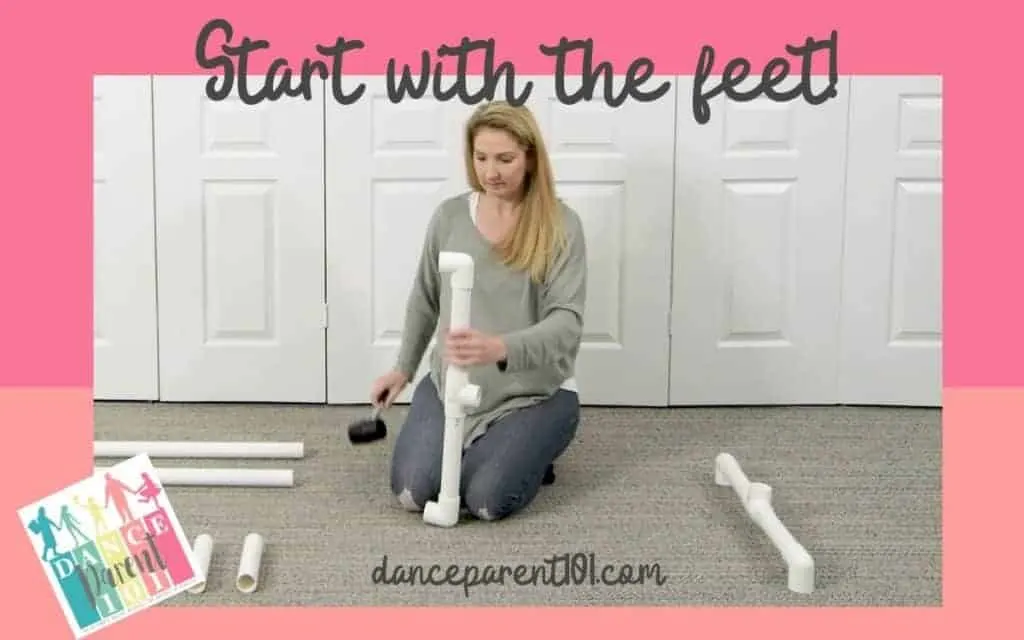
Insert the legs
Insert one of the 26″pieces into the tee fitting that is facing upwards on one of the feet. At the other end of the 26″ fitting push on another tee, so that the two wholes are in line vertically and the single hole is horizontal and make sure that hole is facing towards the other foot you made. Do the same to the other foot with the second 26″ length of pipe.
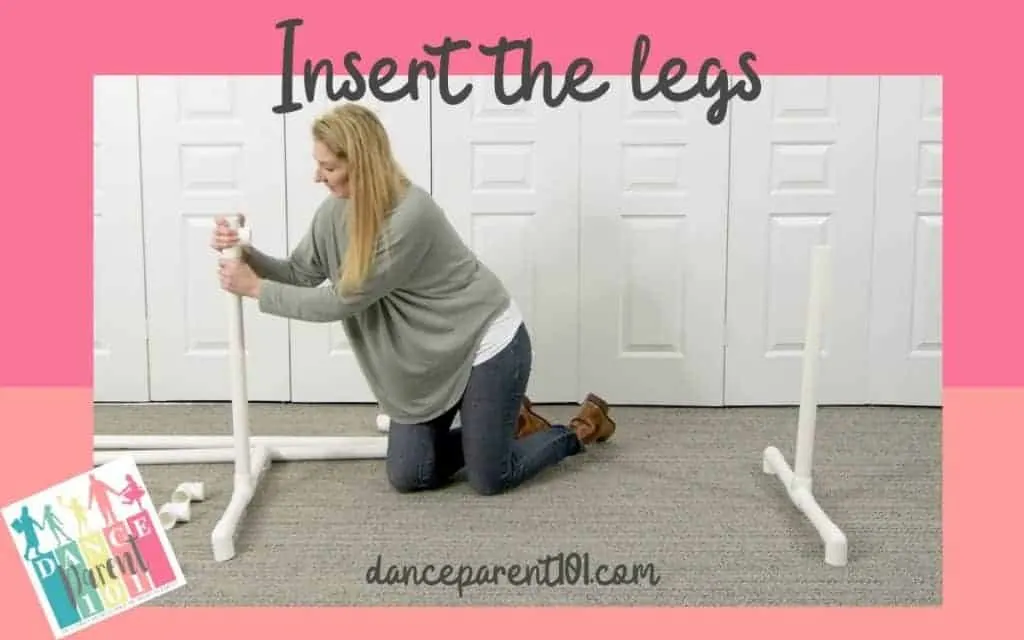
Insert the lower barre.
Pick up one of the 60″ lengths of PVC pipe and insert it into the horizontal tee hole of each leg to make the first lower barre. Once inserted the barre should be able to stand on it’s own.
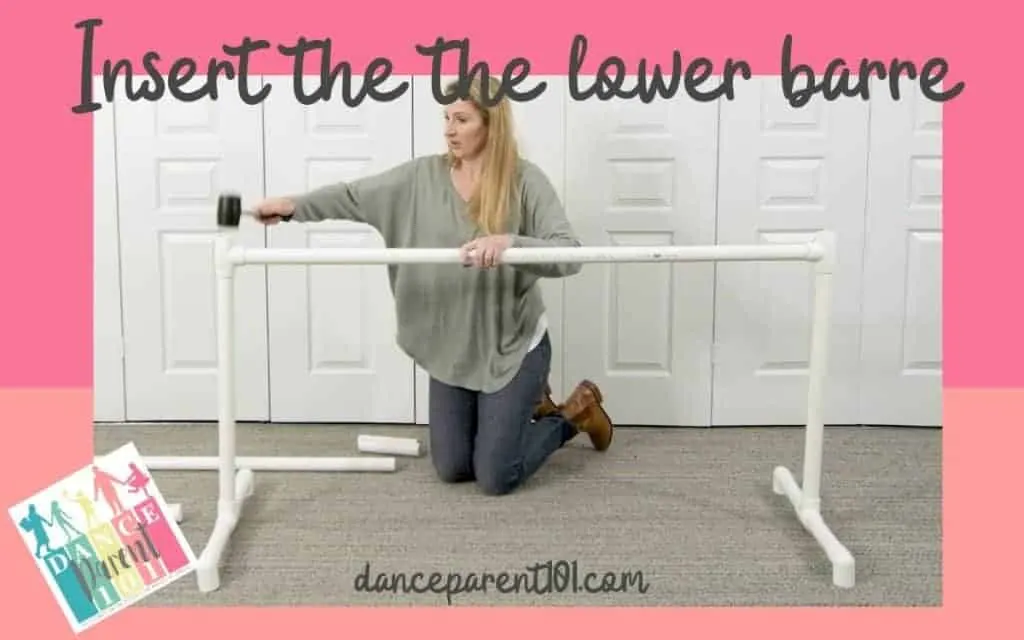
Add on the Height Extensions
Insert the 8″ pieces into each open tee and then place an elbow ontop of each 8″ length of pipe and have the openings face each other.
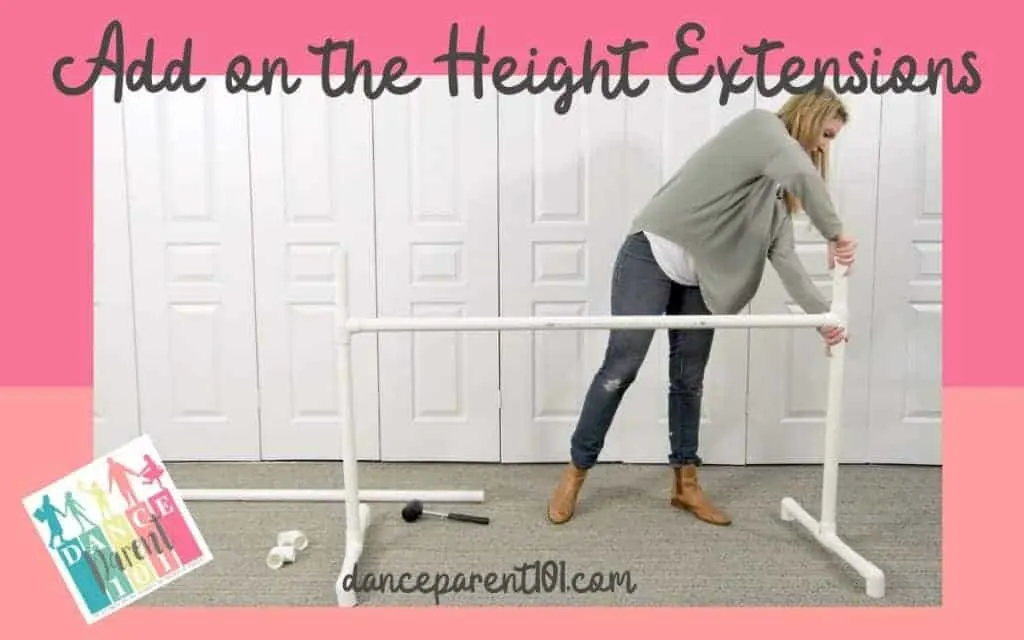
Finish the upper barre.
Insert the final 60″ length into each of these openings to finish off the top barre.
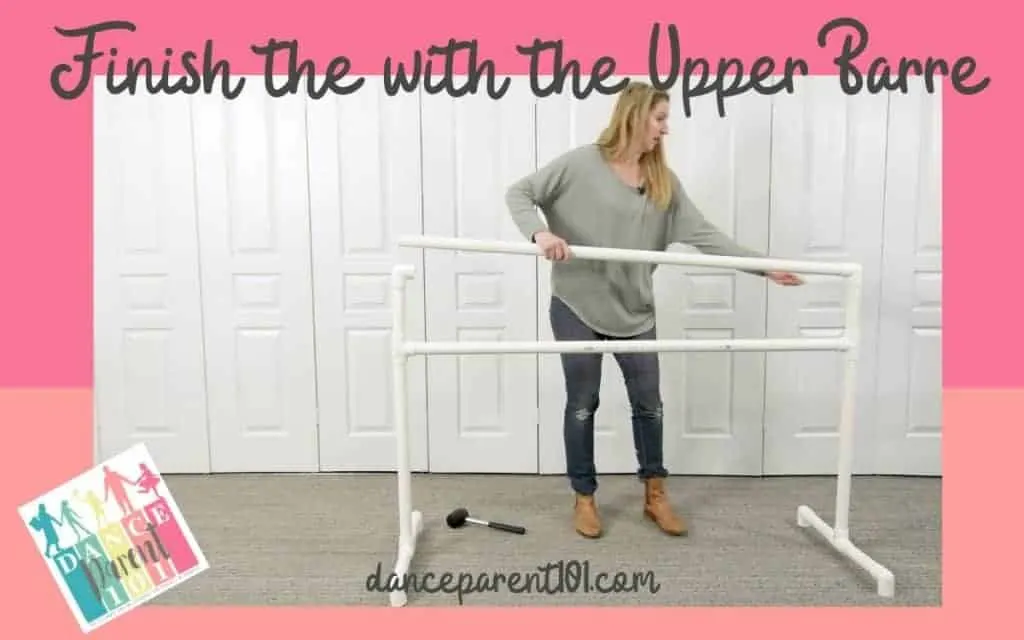
Step 4: Secure the fittings together with a rubber mallet, glue or screws
I have to be honest, after I first made this ballet barre I wasn’t sure what would be the best way to fix all the pieces together and I also didn’t know whether I should fix all of them or leave for example the join between the foot and upright stand alone so that you could swivel the foot to the side and store the barre flat. And so I wanted to experiment on what the best ways to do this would be and you can watch the video on that and read the article here, but before I did that the barres stayed unstuck for weeks – whilst my girls used them for their virtual dance classes during our state quarantine for covid-19.
Not gluing all the pieces together is not ideal for two reasons – it isn’t the safest to use as a part can fall out in the middle of use and because when transporting the barres, pieces kept falling off and it was annoying. But using a rubber mallet to bang the pieces in together did help and the barres were used like this for several weeks of at home practice, but they were much sturdier when fixed together with plumbers cement and you can learn about the best ways to do that here (coming soon).
Step 5: Paint your PVC Ballet Barre
If you have gone ahead and used plumber cement to glue your ballet barre together you will most probably find that the glue has seeped out of the joints and is visible creating purple or green (depending on the color of your glue) drip marks around the pipe joins. In this case, you are most likely going to want to paint your barre so that it loses its DIY look and feels polished and professional.
If you used screws or a clear adhesive for plastics you might decide to keep your ballet barre white like the pipes you used. You still may want to clean all the printed barcodes and identifiers off the pipes and you can easily do this with a cloth and some acetone. Some of my fittings also came with barcodes stuck on them and I had to use a special spray to get the gooey stickiness off them. You can check this all out in the video and article I wrote here about how to clean your barre (coming soon) in preparation for painting as it is the same technique for leaving your barre as it is.
Step 6: Your DIY Ballet Barre is ready to use!
Once hammered together, or glued and painted your ballet barre is ready to use. Just remember Ballet Barres are used for balance and for stretching not for hanging off or for gripping as you just might find.
DIY Ballet Barre E-Book
Why try and work it all out on your own, when I have gone and compiled everything you need to know about making a DIY Ballet Barre into a book! Check it out the e-book where we have newly designed instructional manuals, tips and advice as well as links to the video tutorials, all in one location.

ALTERNATIVE DESIGNS
If this particular ballet barre isn’t what you were after check here for the DIY Ballet Barre home page where I have instructions on how to make single ballet barres, barres from galvanized steel, and using wood. I also have a few suggestions on different styles of feet as well as on how to weigh down your barre so it doesn’t move or what to put under the feet so they don’t scratch wooden floors.
Check Out Our Google Web Story!
LEAVE A COMMENT
I would love to hear your questions or about your barre making experience!!! Leave a comment and I’ll get back to you as soon as I can!!!

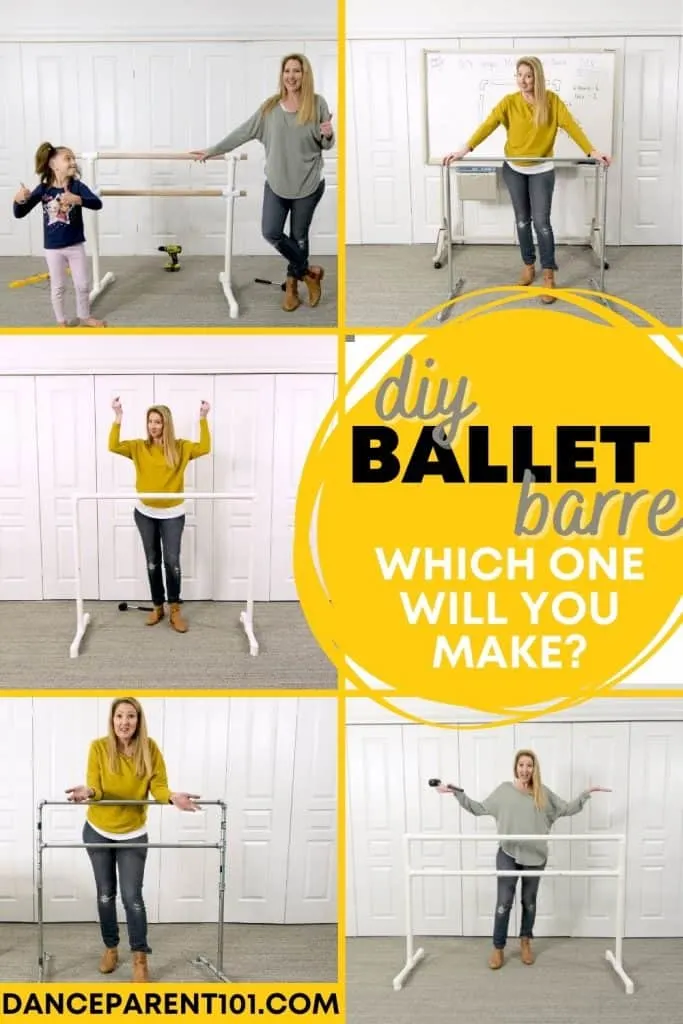

Leave a comment
You must be logged in to post a comment.